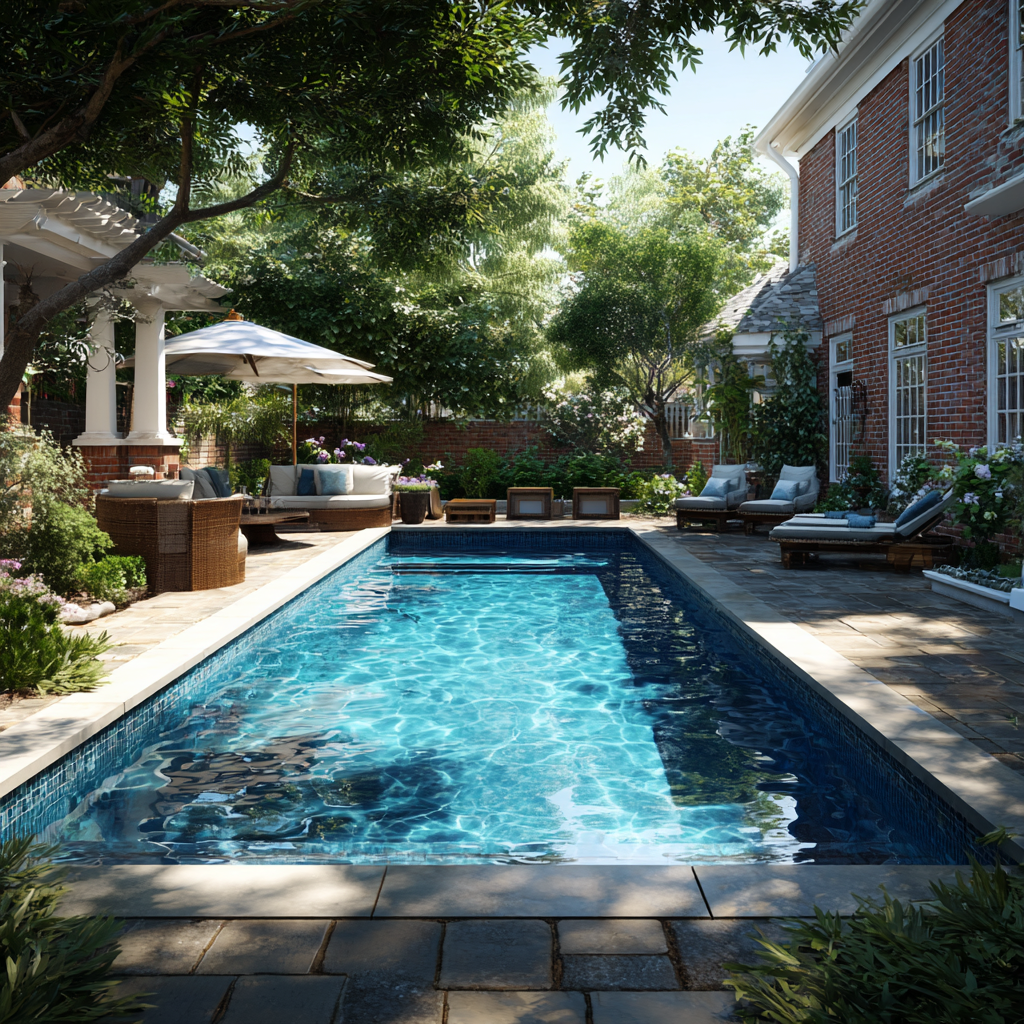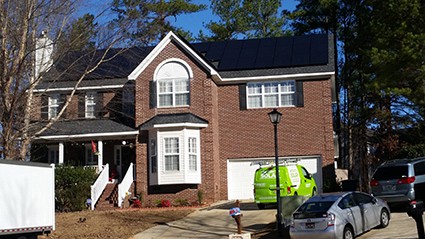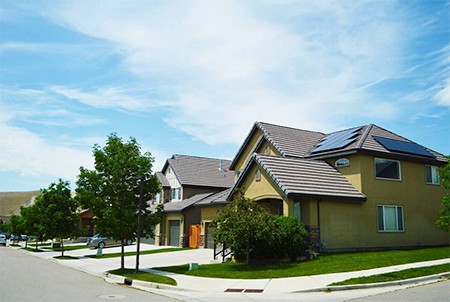What is a Solar Power Heater?
Most forms of energy already produce heat on their own. If you’ve ever put your hand near a running car or by a laptop’s vent, you’ve felt the heat that comes from energy exertion. Anything that moves and generates energy also creates heat as a byproduct. The sun follows similar principles but on a much larger scale. Its massive size and unimaginable surface temperatures radiate enough energy to power the entire planet for several years by itself if it were efficiently collected and distributed. And with that energy comes heat, and lots of it.
Once that heat is absorbed, it has to go somewhere anyway, right? So why not allow it to dissipate evenly across a pipe that’s funneling water into your pool? Solar heaters are an amazing idea because they take the best things about solar heat and combine it with solar panel technology.
The key focus of a solar water heater is not to add a bunch of bulky equipment to your home but to make use of what’s already there. It appeals to solar panel enthusiasts and newcomers alike because all you need to start is a basic solar system. You may already have one for its renewable energy benefits, such as alleviating your utility bill or getting cleaner, environmentally-friendly energy. But whatever the case may be, it’s not too much hassle to add another component to your solar collectors or panels.
Can you Run a Heater Off a Solar Panel?
You can! In fact, that’s how many solar heaters tend to run. Of course, there are other methods, such as getting a separate panel for the heater, but most methods won’t require that. In most cases, the best way to handle solar heating is to use what’s already there, saving you time and hassle.
One thing to keep in mind is how much energy your solar panels are producing. They’re already being used for other purposes, but you may wonder if that energy will be enough to heat the water coming through? To be clear, it won’t take energy from the system because the water pipes aren’t absorbing electricity. It’s not using the solar energy itself—just the heat byproducts of solar energy and electric components. But if your solar panel isn’t doing much work, it won’t be producing much heat. This situation could mean that your pool will take a bit longer to heat up than you might hope, though it wouldn’t mean the system is a waste. It’s just a consideration to think about when deciding whether to install a solar water heating system. It might be time to upgrade to other solar panels, anyway, but those can be expensive by themselves.
What Types of Solar Heating are There?
There are two main types of solar heating. Both effectively heat the water in your pool but come with their own set of advantages and disadvantages.
Active
Active systems keep the water pumping through a system of pipes and valves, sending it around to get heated after cooling. There are two sub-classifications of active heating systems: direct and indirect. Direct circulation means the heated water goes right into your pool or home. It doesn’t pass through anything else after getting heat energy created by the collectors. Indirect systems have the same destination, but they make another stop along the way. Active indirect circulation sends the water through a heat-transfer fluid that prevents freezing before reaching your home or pool. Because of its usefulness against cold weather, cold climate homes love this type of circulation.
Passive
Passive systems are much simpler and cheaper to assemble and are often more reliable and long-lasting. But it does come with a key disadvantage compared to active systems: it is not nearly as efficient because the systems rely a lot on stationary water being heated evenly. It’s still getting funneled through pipes and tanks, but the heating methods involved don’t necessarily bypass a solar panel. Instead, the water is heated in a tank that faces the sun and disperses the heat throughout a large body of water.
Like active systems, passive solar heating systems divide into two categories. There are integral collector-storage passive systems that are better for warm regions requiring lots of hot water day and night. The other type is a thermosyphon system, which uses basic physics to distribute heat throughout a water tank.
The thermosyphon system’s tank starts with warm water at the bottom that then comes to the surface, heating all the water around it. As the molecules rise, they disperse some of their energy to other particles until the whole mixture reaches a uniform temperature. If you’ve watched water boil before, you’ll recall that steam bubbles start at the bottom because that’s where it’s hottest. The same thing works here, just on a larger scale.
How Hot Can a Solar Pool Get?
Generally speaking, solar heaters raise an above-ground pool’s temperature by 6-10 degrees Fahrenheit, with better ones getting up to 15 degrees. Depending on your system and the amount of sunlight you get, the speed at which the pool heats will also vary, but solar heat generally takes longer than gas or electric. It’s also possible to set a certain temperature you want the system to maintain, kind of like a thermostat for your pool. It might not be necessary in every case, but many solar pool systems come with a valve that diverts water to the collector when it gets too cold. You can set this flow control valve to either manual or automatic. If you prefer manual, you’ll probably want a thermometer that checks on the pool’s temperature periodically.
How Efficient is Solar Heating?
Solar heating has comparable efficiency to other types of heating but with some extra advantages. For starters, while the upfront cost can range from cheap to expensive, the system will usually pay for itself after a few years. And even though it takes a while to heat and can have difficulty storing energy, it heats just as well as more expensive systems. Another plus is you don’t have to pay a utility bill for solar power. Except for occasional repairs (and solar panels are praised for being long-lasting and well-built), your solar system won’t cost anything to run monthly. You can’t say the same of electric or gas heating systems—not for pool or home systems.
As we previously mentioned, of the two types of solar heating, active systems get the job done better than passive. Because the hot water cycles more directly through the system instead of sitting in a tank, the water is constantly in motion. There’s not much time wasted while the water sits around and risks losing its heat. Active systems also aren’t as tricky as a passive system’s rooftop tank installation. They may require a bit more attention to maintain than passive systems, but the extra efficiency is worth it.
Can You Heat Your Home with Solar Energy?
Absolutely! A lot of the solar water heating systems also heat water for use in the home. Drawing on heated water from a tank or circulating pipe can bring comfortable water for cleaning, bathing, and cooking. In fact, while setting up heated systems for your pool, it might make sense to add the heated water into your house’s circulation. That way, you can cover your bases if something happens to your current water heating method. While it may take a bit more time and attention, solar heat can provide amazing backup to any system as long as it gets enough sunlight.
How Much does Solar Heating Cost?
The answer depends on the type of system you’re getting and whether you’re or a professional are assembling and installing the parts. But, generally speaking, solar heating can cost up to $1000 or as low as $150. If you want to buy some kind of heat storage, like thermal batteries, that’s going to cost you more. Add-ons like that might be worth it depending on the climate, especially if you’re not expecting a whole lot of sunshine in the coming months. And, of course, a solar system doesn’t require any monthly expenses unless you’re paying off installation costs. But if you have the time and expertise to install it yourself, it won’t cost anything beyond the price of materials.
At Homeowner.org, we’re here to guide you along the way in your journey regarding all things related to buying, owning, and loving your home. Check out our site for more today.



